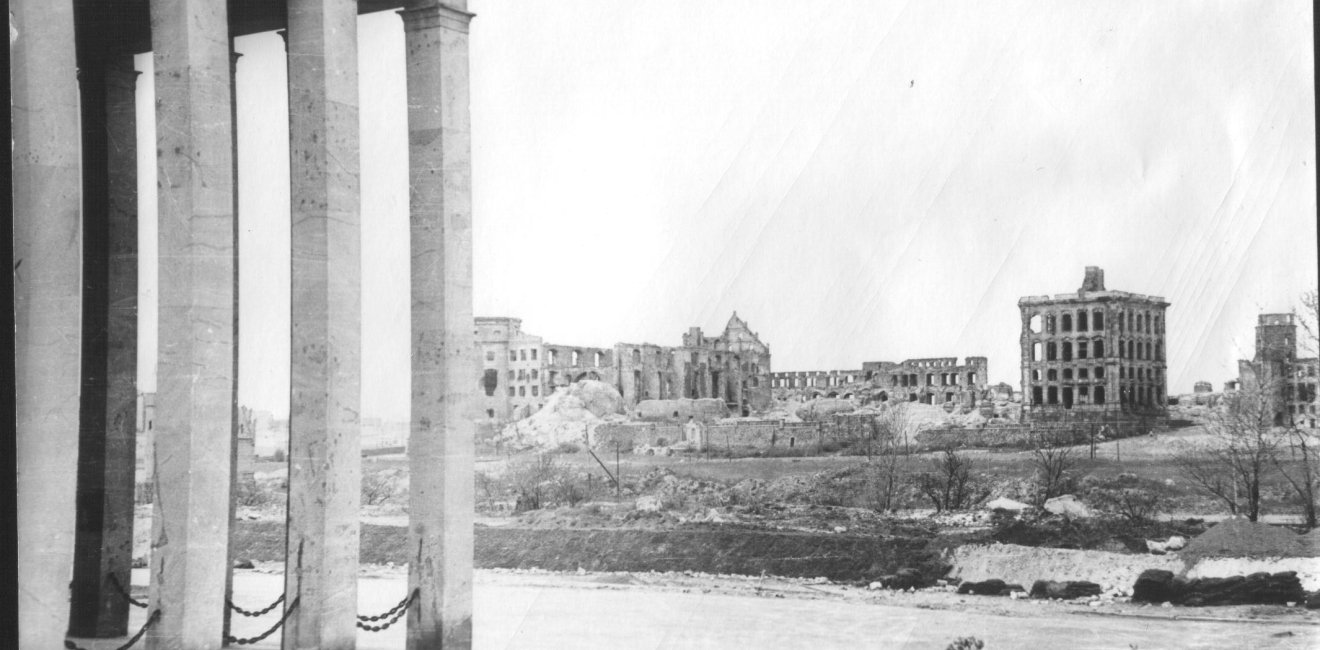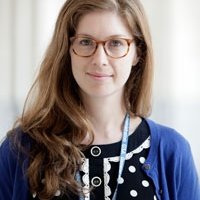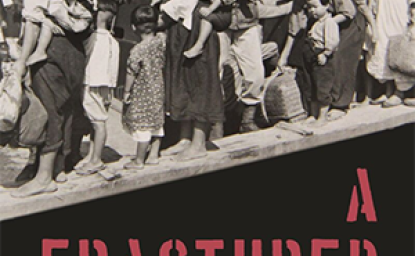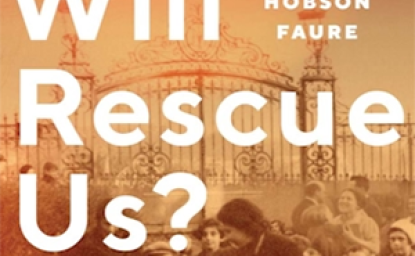In continuation of our alumni interview series, we talked with Title VIII-supported Research Scholar Nicole Eaton to hear her reflections on her fellowship. Dr. Eaton, Assistant Professor of History at Boston College, is writing a book on politics, everyday life, and the German-Soviet encounter in Königsberg-Kaliningrad. See the discussion below on the broader context of German and Soviet occupations, postwar urban rebuilding, nationalities policies, and forced migrations.
Malinkin: Can you talk about some of the ways the Kaliningrad occupation was different from some other Eastern European occupations. What was different about Kaliningrad?
Eaton: What is peculiar about Kaliningrad is that it became part of the Soviet Union—part of the Russian Socialist Republic—but had never been in the Soviet Union before. What is even more peculiar about this place is that when it became Soviet, it did so in a decision-making vacuum; in complete isolation, where it wasn't clear exactly what the future of this place would be. It was only understood from Stalin's conversations during the Conference in Potsdam in 1945 that this territory wouldn't be a German state, and it was later determined that it would be part of Russia. However, neither the military nor Moscow knew what to do with it. What’s interesting to me is how people on the ground had to become self-sufficient, rebuild the city, and make it socialist.
You mentioned that this was the only instance in which two regimes, the Nazis and the Soviet Union, governed the same city, but not as occupiers. Can you explain this?
Kaliningrad is not the analog of a Nazi-occupied Kyiv, Vilnius, or Warsaw. When the Soviets came to Konigsberg to make it Kaliningrad, the idea was that after this brief interim period, by 1946, it would be part of the Soviet Union, a Soviet territory, and that Soviet rules would apply there. If you think in terms of the Nazi occupation of Kyiv, it was understood as a military occupation. Kyiv would never become another Berlin, Stuttgart, or Munich. Kyiv was going to be specifically a city that was in a hierarchy below German cities.
What was the Nazis’ plan for Konigsberg? Did they view it as a second-tier city as well?
Konigsberg had been a German city for seven hundred years, and it was proclaimed after the First World War that its territory, East Prussia, was to be cut off from Germany. But it was absolutely, fundamentally a part of Germany, the same way that Anchorage, Alaska, is cut off geographically, but is an integral part of the United States. This was one of the great frustrations after the Versailles treaty, since this region had been separated, but was still a part of Germany. The Nazis promised to fix that mistake and this made them the most popular party by 1933 (they had the highest number of votes in East Prussia). And they did fix it, when they invaded Poland. They imagined Konigsberg as a template for a Nazi dream of agrarian settlement, of Germany’s small farmers working the land.
When Soviet citizens were sent to Konigsberg, how were they chosen and how much support were they given to rebuild the city? As I understand, there was a "grey period," when the Red Army was on the ground and there was a conscious decision to make this a Soviet city.
Germans remained there for two and a half years before they were all expelled. In October 1945 there were only about 5,000 Soviet civilians, plus the Red Army administrators and half-mobilized troops, who remained behind. The Germans were by far the majority for the first year and a half. Then a large settlement campaign was organized by Moscow with people from central Russia, and, to a lesser degree, from Belarus and Ukraine. They sent mostly ethnic Russians to Kaliningrad to work the land and rebuild the former German factories.
About 400,000 arrived by 1948. They came in a massive wave; some voluntarily, because they were promised tax break incentives, a free cow, free housing, and lots of grain to take with them. They were also given travel passports, which were very rare for collective farmers to receive at that time. When they came to Kaliningrad, many of them left the collective farms immediately, either migrating to the cities, which they were unable to do before, or they went back to their homes and other cities in Russia. Some came hungry, without shoes or food, and found few of the things they had been promised... no houses, only ruins.
Joyous letters were written back home to the collective farms to encourage more people to come, but it was hard to convince people, so the local collective farm boards were given quotas of how many they needed to send to Kaliningrad and other places. They often sent people who were perceived as less useful for the farm – pregnant women, alcoholics, and the less educated, for example.
Besides the Germans, were there also Estonians, Latvians, Lithuanians, and Poles in this area at the time?
There was a strong minority of people who spoke a Polish dialect in East Prussia, but the majority of that territory, the southern two-thirds of East Prussia, went to Poland after the war. In the region that became part of the Soviet Union, there was only a very small number of people with some kind of Lithuanian background. They were mostly assimilated into the German language-speaking population, held German passports, and may or may not have identified themselves as Germans. Interestingly, when German women and Soviet soldiers fell in love or had marriages of convenience, the only way a German woman was allowed to stay during these expulsions was if someone behind the scenes could demonstrate that this person was “actually” Lithuanian, perhaps having lost her passport. People who could speak enough Lithuanian to fake it claimed to be Lithuanian because Lithuanians were collectively redeemed from fascism, since Lithuania was part of the Soviet Union. The Germans in Kaliningrad, meanwhile, were, by late 1947, deemed fascist, permanently contaminated with fascism, and therefore had to be expelled.
So none of the Germans living there were rehabilitated?
The only Germans who remained behind for a longer period were some of the so-called “bourgeois specialists,” the people who were deemed indispensable, and they were also ultimately expelled, too, by the early 1950s. There were only a couple thousand of these people, for example engineers working in the mines.
In this short period, how much interaction was there between the new settlers and the Germans?
In many places in the cities and in the countryside, there was frequent or daily interaction between the remaining German population and new Soviet settlers. Sometimes they lived in the same apartment buildings. There was friendship, love and companionship. However, there were also very unpleasant interactions, as many Soviet soldiers and civilians were still frustrated about the suffering they experienced during the war, and wanted to punish these German civilians for this collective tragedy.
Were the Germans forced laborers?
In the first months after the war, they were not paid except for in food, and not very much food. But later they earned wages. By 1946 work was no longer mandatory, but anyone who did not work did not receive a ration card. They were not imprisoned, but they were not allowed to leave except by expulsion.
When they were expelled, where were they sent?
They were sent to the Soviet occupation zone, just over the border, into what was to become East Germany. Anyone who had a family connection in the Western allied zone tended to go there. Those who didn't remained behind in what became the GDR.
How much support did the first group of settlers get from officials in the sending cities and villages? Did they send specialists to help them run the factories and farms, etc.?
They were expected to rebuild Kaliningrad’s infrastructure, but with very little support. In 1946, Kaliningrad was not included in any post-war budget or in the first postwar Five-Year Plan. It was only a special line item on the budget. Demands were coming from various organizations and agencies, but without the budget or the labor force to fulfill them.
Local decisions drove the expulsion of the German population. Soviet history in the Stalin period is very much characterized by a search for the “enemy within.” These expulsions were very similar to the great purges and the Terror, where the need to explain the failure or delay of building Socialism led to the identification of a pre-packaged enemy. It was very easy to find such an enemy in the Germans who were not working hard (in part because they were starving), and who were suspected never to have been cured from the ‘disease’ of fascism.
How did this play out in making it a Soviet city?
This was a city that previously had much greater amenities than any other Soviet city, but it remained in ruins for years. For the first several years after the end of the war, there was no electricity in most parts of the city, no clean water supply, public transportation was rudimentary, and the city center remained in shambles. How could Socialism prove itself better than what it was replacing, if it could not rebuild this city? In that unspoken frustration and confusion, they began to think of building Socialism in terms of eliminating Germanness. Not only swastikas and other Nazi symbols, but also eliminating the German-looking facades of buildings and trying to broaden the streets, because German streets were ‘medieval.’
When did it become fairly functional or return to its pre-war condition, more or less?
Arguably, the city never returned to its prewar condition. There were many plans to rebuild a new Kaliningrad modeled on the plan for a new Moscow of the 1930s. There would be wide streets radiating to the center, there would be a tower with a giant statue of Lenin on top, the symbol of the city, the way the Kremlin was in Moscow, radiating outward. There were all these grand, modern plans for a Socialist city in high Stalinist style. They weren’t realized though, so the city grew up very pragmatically in a suburb of the city, and the city center remained empty for decades. The ruins of the old castle—the former city center—were only destroyed in the late 1960s. In the 1970s and early 1980s, they tried to build a House of Soviets that would be the new center. By that point it looked like a brutalist pre-fab building, but they built it on a former swamp, and the foundation was unsound, so the building was never finished. Even today as the Kaliningrad economy goes up and down, the prospects for building a proper city center continue to rise and fall.
What kind of condition is Kaliningrad in today?
It is now a lively, bustling city that has improved from the 1990s when it was the absolute worst place to be in Russia, with the highest HIV rate, terrible narcotics problem, and a poverty rate over 50% because it was cut off from its networks, the same way Konigsberg was after the First World War. It suffered terribly. EU and Russian investment has helped improve that, but efforts to make Kaliningrad a Russian Hong Kong haven't really turned out because of political difficulties on both sides and the constant issue of NATO expansion and Russia's push-back against it. So, in the past 50 years, Kaliningrad has, in some ways, become quite lively, but it remains a sort of urban-planning disaster because it grew up out of a de-facto suburban area.
What is the time period that you study and how did you choose it?
I am looking at 1939-1949 because that’s the period when Germany first made its march into Eastern Europe, planning to incorporate the new territories of Poland. During the Second World War, Konigsberg was connected to the occupation of Ukraine through the leader of Konigsberg, who became a Reichskomissar of Ukraine. I stopped the story with the Nazi-Soviet encounter in the city, which is the final expulsion of the German population. At that point, the city was still dealing with many challenges of rebuilding, but dealing with them on different terms. They decided that the German people should leave.
How did the average citizen perceive the Soviet Union's place in the world at the time? What was the Soviet ideology? How did people in Kaliningrad view it?
This is really central to the work I'm doing. Through the diaries, memoirs, letters, and oral history, ordinary Soviet civilians and Red Army soldiers thought that, on the one hand, socialism was more just and humane. On the other hand, there was a very powerful emotional understanding that this war had been the Great Patriotic War, and there was great pride. Progressiveness, but also an exclusionary sense of pride for being Russian, being Soviet, led to a lot of inconsistencies in the treatment of Germans, trying to figure out what to do with the people they beat.
Were these emotions and perspectives that someone in other, further parts of Russia might not have?
In general, I think these ideas were part of the world-view or self-understanding of almost all Soviet people because they were reading it in the newspapers and they were discussing their victory in those terms, whether or not they were coming into contact with Germans. I think what is particular about the Kaliningrad case is that they actually had to test these ideas out in practice, in a way which was unexpected to them, without a clear-cut answer.
Even with EU and Russian rehabilitation of the city after the 1990s, did it ever become a major destination for Russian entrepreneurs?
Oh, it has certainly! Kaliningrad has recovered somewhat in the last 10-15 years and became one of the major sites, other than Moscow and St. Petersburg, for Russians returning to Russia from Central Asia and the Caucasus. There were a number of people coming from Bishkek who were ethnic Russians, who felt they could no longer build their lives in Central Asia, as these Republics were changing and the attitude towards ethnic Russians, who had been there for generations, shifted.
So they thought of Kaliningrad as a place that was livable and where property was more or less affordable at the time, although now it has become quite expensive due to speculation and development.
Could you describe any parallels, any similarities that you see with the annexation of Crimea? What that population might be going through?
The parallel I see between Kaliningrad and Crimea today, is that Kaliningrad will never be the stronghold Crimea might, because Kaliningrad is being presented by Putin as a thorn in the side of the EU and NATO. But on the other hand, it is very vulnerable. Kaliningrad can’t actually pose a threat, because it is surrounded. I think a lot of the challenges for NATO are going to be focused around Kaliningrad as this constant reminder. There have been numerous exercises and counter-exercises on both sides of the border and that's going to continue; it’s part of the symbolic value of Kaliningrad. In terms of Crimea and Kaliningrad, both very similar as places that are not completely integrated into the Russian economy (Kaliningrad for obvious reasons, and Crimea because of its newness), both are going to be major focuses for the Russian government as they try to keep the populations loyal by keeping food prices under control, by building a diverse, sustainable economy, or by pumping artificial investment or artificial funds into this region to keep the populations content.







